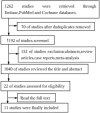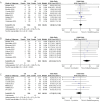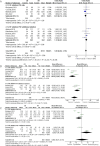Cryoballoon versus radiofrequency ablation for persistent atrial fibrillation: an updated systematic review and meta‑analysis
- PMID: 40676688
- PMCID: PMC12273244
- DOI: 10.1186/s40001-025-02911-x
Cryoballoon versus radiofrequency ablation for persistent atrial fibrillation: an updated systematic review and meta‑analysis
Abstract
Background: Compared with paroxysmal atrial fibrillation, persistent atrial fibrillation (AF) is more harmful and difficult to treat, and the efficacy of different catheter ablation for both also varies greatly. So this study aimed to systematically evaluate the efficacy and safety of cryoballoon (CB) and radiofrequency (RF) ablation in the treatment of persistent AF.
Methods: We searched the PubMed, Embase, and Cochrane library databases for studies comparing the efficacy and safety between CB and RF ablation for persistent AF. All included studies met our inclusion criteria.
Results: A total of 11 studies, 2551 patients were enrolled in this study, including 1256 patients in CB group and 1295 patients in RF group. Meta-analysis results showed that the freedom from atrial tachyarrhythmia (ATA) recurrence was similar between the CB and RF groups (OR 1.00, 95% CI 0.85 to 1.18, I2 16%). The results of repeated ablation events in the two groups were similar (OR 0.85, 95% CI 0.64 to 1.12, I245%), while the operative time in the CB group was shorter than that in the RF group (mean reduction 45.27 min, 95% CI 61.34 to 29.20 min, I2 95%). There was no significant difference in fluoroscopy time between the two groups (mean difference 2.12 min, 95% CI 7.83 to 12.07 min, I2 99%). The incidence of total complications was similar between the two groups (OR 1.08, 95% CI 0.74 to 1.58, I2 0%), but phrenic nerve palsy (PNP) was more likely to occur in the CB group (OR 4.84, 95% CI 1.84 to 12.71, I2 0%). The incidence of pericardial tamponade was not statistically different between the two groups (OR 0.72, 95% CI 00.32 to 1.58, I2 0%).
Conclusions: CB can be used as an alternative therapy to RF for persistent AF, both of which have considerable efficacy and safety. CB can significantly reduce the operation time with the probability of high PNP.
Keywords: Cryoballoon ablation; Meta-analysis; Persistent atrial fibrillation; Radiofrequency ablation.
© 2025. The Author(s).
Conflict of interest statement
Declarations. Ethics approval and consent to participate: There are no ethical issues involved in this meta-analysis. Competing interests: The authors declare no competing interests.
Figures






Similar articles
-
Cryoballoon versus radiofrequency ablation for paroxysmal atrial fibrillation: a meta-analysis of randomized controlled trials.Clin Res Cardiol. 2018 Aug;107(8):658-669. doi: 10.1007/s00392-018-1232-4. Epub 2018 Mar 21. Clin Res Cardiol. 2018. PMID: 29564527
-
Efficacy and safety of the second-generation cryoballoons versus radiofrequency ablation for the treatment of paroxysmal atrial fibrillation: a systematic review and meta-analysis.J Interv Card Electrophysiol. 2017 Jan;48(1):69-79. doi: 10.1007/s10840-016-0191-9. Epub 2016 Sep 28. J Interv Card Electrophysiol. 2017. PMID: 27683062
-
Comparison of catheter ablation for paroxysmal atrial fibrillation between cryoballoon and radiofrequency: a meta-analysis.J Interv Card Electrophysiol. 2017 Apr;48(3):351-366. doi: 10.1007/s10840-016-0220-8. Epub 2017 Jan 7. J Interv Card Electrophysiol. 2017. PMID: 28063111
-
Curative catheter ablation in atrial fibrillation and typical atrial flutter: systematic review and economic evaluation.Health Technol Assess. 2008 Nov;12(34):iii-iv, xi-xiii, 1-198. doi: 10.3310/hta12340. Health Technol Assess. 2008. PMID: 19036232
-
Endovenous ablation therapy (laser or radiofrequency) or foam sclerotherapy versus conventional surgical repair for short saphenous varicose veins.Cochrane Database Syst Rev. 2016 Nov 29;11(11):CD010878. doi: 10.1002/14651858.CD010878.pub2. Cochrane Database Syst Rev. 2016. PMID: 27898181 Free PMC article.
References
-
- Benali K, et al. Impact of catheter ablation of atrial fibrillation on disease progression. JACC Clin Electrophysiol. 2025;11(2):421–35. - PubMed
-
- Hindricks G, et al. Catheter ablation of atrial fibrillation: current status, techniques, outcomes and challenges. Kardiol Pol. 2018;76(12):1680–6. - PubMed
-
- Van Gelder IC, et al. 2024 ESC Guidelines for the management of atrial fibrillation developed in collaboration with the European Association for Cardio-Thoracic Surgery (EACTS). Eur Heart J. 2024;45(36):3314–414. - PubMed
Publication types
MeSH terms
LinkOut - more resources
Full Text Sources
Medical
Research Materials
Miscellaneous

